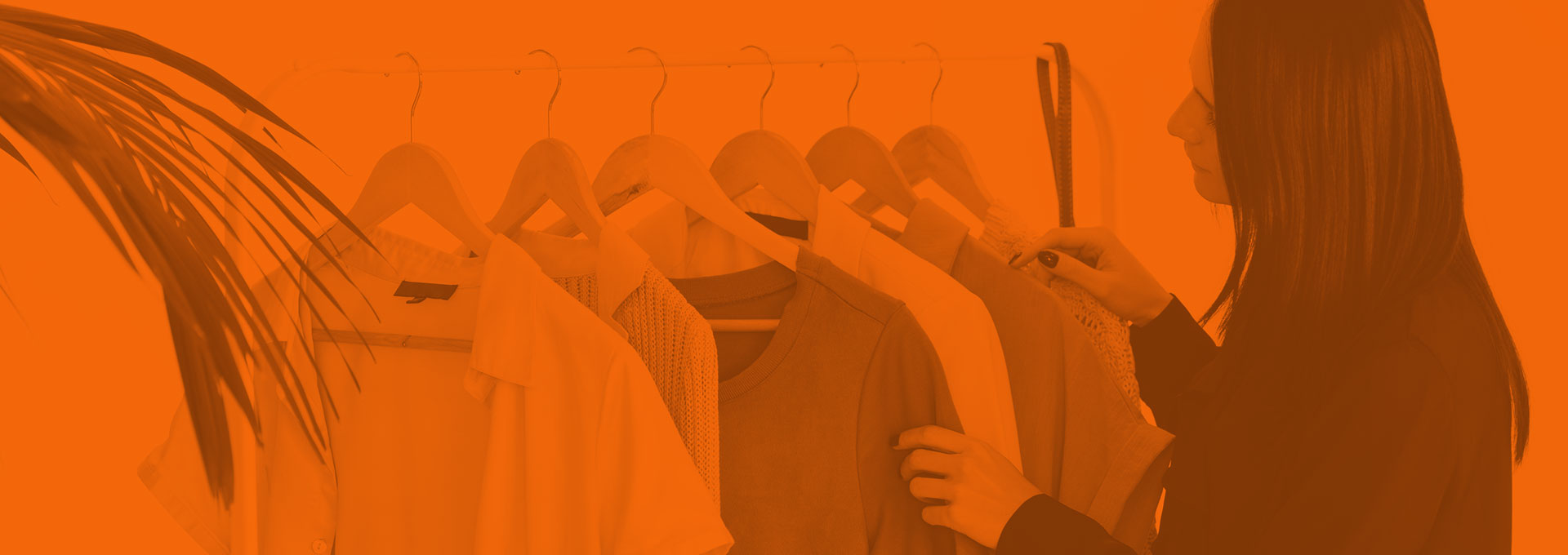Sustainable Marketing in the Fashion Industry
The global fashion market was worth $1.46 trillion in 2020 and is projected to rise to 2.25 trillion by 2050. Today, 80 billion pieces of clothing are consumed globally each year.
Fashion is a tool for self-expression. A new blouse, t-shirt, or hat can define an individual’s mood, character, and wealth. Yet, behind the polished Gucci shoes and chic Prada bag, fashion can have a sinister side.
A single pair of jeans can use 18 gallons of water, 1.5 kilowatts of energy, and 5 ounces of chemicals. This concentration of energy and resources is then lost into landfills, with a textile recycling rate of 14.7% in the U.S.
With this in mind, brands such as Reformation, Zady, Petite Lucette, and United By Blue are taking steps to minimize the industry’s carbon footprint and implement ethical practices too, without compromising style.
Becoming a sustainable fashion brand needs careful planning which considers the environmental and social impacts of the industry.
Yet, operating sustainably is not the end of the sustainability journey. Once fashion brands have taken steps to improve operational sustainability, they then need to market their efforts effectively.
This article will teach you how to effectively market a sustainable fashion brand using 8 simple steps.
Marketing Your Sustainability in the Green Fashion Industry
“Sustainable marketing is the marketing of sustainable products in a sustainable way. We’re not printing hundreds of flyers and throwing them around the streets; we’re educating consumers so they can make more informed decisions about which products to buy when they need them. ” – Nick Spensley, head of PR and marketing at UK-based sister brands Togetherband and Bottletop
Sustainable marketing is a tool that helps businesses use their sustainability credentials as a unique selling point (USP) to promote their environmental and socially responsible products, practices, and brand values accurately and transparently.
Both accurate and transparent marketing must be highlighted here. Over exaggerated green claims (termed as greenwashing) are unethical and breach U.S. legislations, such as:
- The Federal Trade Commission Act (FTC Act)
- The Lanham Act (see Lanham Act and Chapter 22, Lanham Act)
- The National Advertising Division of the Better Business Bureau which oversees national self-regulation
The Value of Sustainable Fashion Marketing
Green fashion, otherwise known as sustainable fashion, is a movement and process of fostering change to products and systems to create more sustainable fashion brands. Businesses have to sell to survive, yet fashion brands won’t last long-term if they don’t operate on greener values.
Thinking in the short term, the argument for sustainability is equally compelling. Using sustainable marketing to promote green fashion augments short-term business benefits. For instance, NYU Stern’s Center for Sustainable Business concluded that products marketed as sustainable grew 5.6 times faster than those that were not. This is because sustainable marketing benefits businesses by:
- Improving brand image: A 2020 IBM survey reported that 77% of respondents preferred environmentally responsible products, indicating sustainability was either very or moderately important to them. Sustainable marketing showcases your business’s environmental and social responsibility which can only work to improve the perception of your brand as an ethical choice for the increasingly informed consumer.
- Improving employee retention and recruitment rate: A 2020 Reuters survey found that 65% of survey respondents were more likely to work for a company that had strong environmental policies. Sustainability marketing communicates your company’s sustainability ethos across a global talent pool. Working in line with this talent pool’s values improves both retention and recruitment rate.
- Attracting investment: A sustainability agenda will guide investment decisions at a portfolio level. In 2018, over half of global asset owners were currently implementing or evaluating sustainability in their investment strategy.
Combining sustainable marketing and fashion marketing
Fashion marketing is a branch of marketing that uses advertising campaigns and promotional events to sell clothing and accessory items to target consumers.
If a fashion business has worked hard to operate more sustainably, then they deserve to shout about what they’ve got right, while also communicating their ongoing sustainability goals. This is where the two disciplines, sustainable marketing and fashion marketing, overlap.
Detailed below are 8 steps to help you combine sustainable marketing with fashion marketing, to effectively communicate and promote your sustainable operations and fashion brand.
8 steps for effective sustainable fashion marketing
Sustainable marketing in fashion may sound like an oxymoron. After all, promoting newness encourages more purchases, which drives business growth and expands operations that demand resources.
This is especially true for fast fashion, and brands that use greenwashing to cover up their unsustainable operations.
“The jargon we’ve created around sustainability allows consumers to shop in a more guilt-free way. If you’re really trying to be sustainable, you need to produce and buy less.” – Camille Charriere
When done correctly, however, sustainable marketing in fashion can promote a behavioral shift that supports conscious consumption, a circular economy, and the demand for higher quality goods which challenge the fast-fashion market. The 8 steps given below will help you effectively deliver sustainable marketing in fashion.
Step #1: Maintain a Good Design
Being a sustainable fashion brand doesn’t mean neglecting the design of your product. If your products are environmentally and socially responsible, but the design isn’t great, no one will buy your products and this isn’t sustainable.
Take the French brand VEJA for instance. The Veja brand has strong environmental and social commitments, plus customers remain to rate the brand’s thoughtful and stylish design.
“The sneakers are just incredible!!! Everything is perfect!! The color, the design, how comfortable, and best of all, the vegan/ecological side.” – VEJA customer review
Step #2: Define Your Target Persona
Your target persona is the ideal customer you want to attract using your marketing message.
You need to market your sustainable fashion brand to the right audience. Just as your brand will cater to more than one audience (age, demographics, interests), there’s more than one type of sustainable audience to target.
Below are four key audiences you can target with sustainability marketing:
- The Enthusiastic Expert: This is a consumer who prioritizes whole-system thinking. They are 35-45 years old, live in rural areas, have medium to high levels of education, and are dedicated to sustainability and eco-friendly living. They believe businesses should pay higher taxes for unsustainable behavior. Brands have to show this persona that they can meet their high expectations.
- The Inspired Innovator: This is a younger consumer, including generation Z and Millennials who have urban or higher-education backgrounds. This persona prioritizes innovation and forward-thinking policies. They are somewhat knowledgeable and vocal about sustainability. Brands have to show this persona they are at the forefront of sustainable development, with a thought-promoting message alongside interesting products and innovative thinking.
- The Considerate Conventionalist: This is a group of slightly older consumers, usually aged between 45-65, living in rural areas. As an audience, the group appreciates transparency, knowledge, and empowerment. They view sustainable brands as important, but less so than the other personas. They are somewhat knowledgeable about brands that offer sustainable goods and are open to pay more for sustainability. To coax this persona, you need to provide them with plenty of information and transparency.
- The Reserved Rationalist: These are consumers who are on the lookout for value themselves. Again, they are slightly older, in the 35-44, 45-55, and 55-65 age ranges, and live in urban areas with medium to high education levels. However, if there’s an audience you’ll struggle to convince about the positives of sustainability, then it’s this one. They are unwilling to pay more for sustainable goods, being neither knowledgeable nor vocal about sustainability. To appeal to this group, you need to show them how your service or product will provide value.
Choose your sustainability persona carefully and market to this persona.
Step #3: Use Digital Storytelling
Creators around the globe are melding storytelling techniques with contemporary, digital forms of communication. Multimedia tools, such as videos, blogs, and podcasts bring narratives to life. This is called digital storytelling.
You can use digital storytelling to guide your consumers through your sustainability story. Help them understand how investing in your brand will play a part in positive change. Studies show that shaming consumers and making them feel bad about buying non-ethical clothing can have adverse effects. Instead, many retailers focus on empowering consumers, and storytelling helps create a sense of overall authenticity for this empowerment.
Think about who’s going to view your story and who’s going to buy your products. Give a narrative behind your brand’s clothes to help your target personas connect on a deeper level, and spark a growing interest in sustainability.
Digital forms of communication, such as social media, blogging, and video are great platforms to share your brand’s story cheaply and on a global scale.
For example, the sustainable clothes manufacturer, Industry of All Nations, hones in on the background of the people that produce their products to drive their marketing message. Focusing on stories as opposed to consumer motivation means Industry of All Nations bypasses telling people what to do with preachy tones.
Step #4: Keep Your Message Simple and Direct
Keep your message simple by focusing on one keyword to grab your customer’s attention. Once you have this attention, you can tell them more later. You need a message that truly packs a punch.
For instance, the Swedish retailer H&M’s “Conscious Collection” uses a variety of different sustainable raw materials using recycled fabrics, namely Tencel and organic cotton. However, every product is marketed under the same message “Conscious Collection”, keeping the marketing simple. It’s only when the customers dig deep that they learn about the specific materials used in each product and their environmental benefits.
Once you’ve defined your message, use direct, clear, and consistent language, avoiding irrelevant terms and unsupported claims. You don’t want to overwhelm your consumers with too much information.
Next, think about the words you’re using in your marketing message. For instance, a study by Shelton Group tested the perceptions of 11 green buzzwords commonly used to market sustainable products and services. Some terms truly resonate with customers while others lose them.
Words like “green”, “eco-friendly”, and “sustainable” were found to have a broad appeal among consumers. However, brands must be wary when using these words as they can set up unrealistic expectations. Make sure to back up your statements with statistics to justify their use.
In summary, when it comes to marketing your sustainable fashion brand, words matter.
Step #5: Engage Your Customers and Network with Like-Minded People
Engage your customers with the sustainability conversation and let them be a part of the journey and solution.
You could create a channel within your communication platforms that allows your customers to share their sustainability ideas, plus how they can use, wear and recycle your fashion products. For instance, the U.S. brand Levi challenged their consumers to find the most innovative and sustainable air-drying solution for clothing in their campaign “Care to Air Design Challenge”.
In terms of networking, make sure you’re keeping up to date with the relevant sustainable fashion scene. This means networking with like-minded people and organizations. Check out sustainable fashion events and trade fairs in your local areas, e.g. Remode in Los Angeles and The Australian Circular Fashion Conference in Melbourne.
Step #6: Be Creative
Creative imagery, branding, and storytelling will help you market your clothes to the mainstream fashion crowd. Think about your brand’s tone, and how you can use this to stand out from your competition.
For instance, the Los Angeles brand Reformation launched with the following message in 2009:
“Being naked is the most sustainable option. We are #2.”
Reformation carried this well-crafted, quirky tone throughout their marketing strategy. Another example is their #sexymath infographics. In so doing, Reformation communicates their sustainability credentials creatively and engagingly. Today, the brand has a cult-like following referred to as Refbabes on Instagram and raised $25 million series B funding in 2017.
Step #7: Be Sustainable and Transparent
As mentioned, accurate communication of your brand’s sustainability credentials is vital.
For one, to market yourself as a sustainable fashion brand, you need to be a sustainable fashion brand. This means thinking about the materials you use in marketing, and the impact these have on the environment. Digital marketing helps organizations reach a global audience with few resources.
You must also keep in mind that no brand is 100% sustainable, so don’t market yourself as such. Communicate your challenges as much as your sustainability successes.
Take Patagonia’s “Everything But The Teeth Campaign” as an example. Here, Patagonia markets their new jacket as a sustainable alternative because the fabric used is recyclable. However, Patagonia acknowledges there’s still work to be done before they can advertise their jacket product as completely recyclable due to the zipper. For Patagonia, making the zipper – the jacket’s “teeth” – recyclable is their next challenge. Patagonia transparently showcases sustainability as a journey and not a final destination.
Step #8: Get Certified
Get certified to give credibility to your sustainability claims. Consumers are more likely to turn to well-regarded green credentials, such as:
Certification will validate your green efforts for your sustainable fashion brand and help you communicate your success accurately.
For instance, the fashion brand Petite Lucette launched in 2014 with the mission of creating an organic line of products. To help them with this aim, Petite Lucette joined GBB to expand their sustainable initiatives and gain the seal of approval they deserved. As a Green Business Bureau certification holder, Petite Lucette has a suite of 400+ initiatives to choose from for sustainable development. They can then share their progress with employees, stakeholders, and the world using their unique EcoProfile.
Follow These 8 steps to market your sustainable fashion brand
When done correctly, sustainable marketing in the fashion industry will promote responsible consumption and drive a behavioral shift away from fast fashion, and environmentally damaging and unethical business practices. By skillfully marketing your sustainable fashion brand, you communicate the importance and value of having a sustainable business model.
Creativity, honesty, transparency, and storytelling give us the power to remodel an entire industry for greater sustainability.
Jane Courtnell is a Content Writer for Process Street. With a Biology degree from Imperial College London and further studies at Imperial College’s Business School, Jane has an enthusiasm for science communication and how biology can be used to solve business issues, such as employee wellbeing, culture, and business sustainability.



